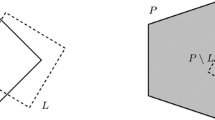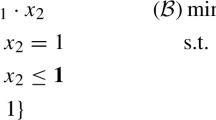Abstract
We study different extended formulations for the set \({X = \{{\boldsymbol x}\in \mathbb{Z}^n \mid {\boldsymbol A}{\boldsymbol x} = {\boldsymbol A}{\boldsymbol x}^0\}}\) with \({{\boldsymbol A} \in \mathbb{Z}^{m \times n}}\) in order to tackle the feasibility problem for the set \({X \cap \mathbb{Z}^n_+.}\) Pursuing the work of Aardal, Lenstra et al. using the reformulation \({X=\{{\boldsymbol x} \in \mathbb{Z}^n \mid {\boldsymbol x}-{\boldsymbol x}^0={\boldsymbol Q}{\boldsymbol \lambda},\,{\boldsymbol \lambda} \in \mathbb{Z}^{n-m}\}}\) , our aim is to derive reformulations of the form \({\{{\boldsymbol x} \in \mathbb{Z}^n \mid {\boldsymbol P}({\boldsymbol x}-{\boldsymbol x}^0)={\boldsymbol T} {\boldsymbol \mu}, {\boldsymbol \mu} \in \mathbb{Z}^s\}}\) with 0 ≤ s ≤ n − m where preferably all the coefficients of P are small compared to the coefficients of A and T. In such cases the new variables μ appear to be good branching directions, and in certain circumstances permit one to deduce rapidly that the instance is infeasible. We give a polynomial time algorithm for identifying such P, T if possible, and for the case that A has one row a we analyze the reformulation when s = 1, that is, one μ-variable is introduced. In particular, we determine the integer width of the extended formulations in the direction of the μ-variable, and derive a lower bound on the Frobenius number of a. We conclude with some preliminary tests to see if the reformulations are effective when the number s of additional constraints and variables is limited.
Similar content being viewed by others
References
Aardal K., Bixby R.E., Hurkens C.A.J., Lenstra A.K., Smeltink J.W.: Market split and basis reduction: Towards a solution of the Cornuéjols-Dawande instances. INFORMS J. Comput. 12, 192–202 (2000)
Aardal K., Hurkens C.A.J., Lenstra A.K.: Solving a system of diophantine equations with lower and upper bounds on the variables. Math. Oper. Res. 25, 427–442 (2000)
Aardal, K., Lenstra, A.K.: Hard equality constrained integer knapsacks. Mathematics of Operations Research, 29(3), 724–738 (2004). Erratum: Mathematics of Operations Research, 31(4), p. 846 (2006)
Andersen, K., Pochet, Y.: Coefficient strengthening: a tool for formulating mixed integer programs. CORE DP 2007/24, Université catholique de Louvain (2007)
Bradley G.H.: Transformation of integer programs to knapsack problems. Discrete Math. 1, 29–45 (1971)
Bradley G.H.: Equivalent integer programs and canonical problems. Manage. Sci. 17, 354–366 (1971)
Bradley G.H., Hammer P.L., Wolsey L.A.: Coefficient reduction for inequalities in 0-1 variables. Math. Program. 7, 263–282 (1974)
Cassels, J.W.S.: An Introduction to the Geometry of Numbers. Classics in Mathematics. Springer, Berlin (1997). Second Printing, Corrected, Reprint of the 1971 ed.
Cornuéjols G., Dawande M.: A class of hard small 0-1 programs. INFORMS J. Comput. 11, 205–210 (1999)
Cornuéjols G., Urbaniak R., Weismantel R., Wolsey L.A.: Decomposition of integer programs and of generating sets. In: Burkard, R.E., Woeginger, G.J.(eds) Algorithms–ESA ’97. Lecture Notes in Computer Science, vol. 1284, pp. 92–103. Springer, Berlin (1997)
Kannan R.: Algorithmic geometry of numbers. Annu. Rev. Comput. Sci. 2, 231–267 (1987)
Kannan R., Bachem A.: Polynomial algorithms for computing the Smith and Hermite normal forms of an integer matrix. SIAM J. Comput. 8, 499–507 (1979)
Karamanov, M., Cornuéjols, G.: Branching on general disjunctions. Working paper, Tepper School of Business, Carnegie Mellon University (2005). Revised September 2007. To appear in: Chvátal, V., Sbihi, N. (eds.) Proceedings of the Montreal 2006 NATO Conference
Lenstra A.K., Lenstra H.W. Jr, Lovász L.: Factoring polynomials with rational coefficients. Math. Ann. 261, 515–534 (1982)
Lenstra H.W. Jr.: Flags and lattice basis reduction. In: Casacuberta, C., Miró-Roig, R.M., Verdera, J., Xambó-Descamps, S.(eds) Proceedings of the third European Congress of Mathematics, vol. I, pp. 37–51. Birkhäuser Verlag, Basel (2000)
Lenstra, H.W. Jr.: Lattices. To appear in: Surveys in Algorithmic Number Theory, Mathematical Sciences Research Institute Publications, Cambridge University Press, Cambridge (2005)
Lovász L.: An Algorithmic Theory of Numbers, Graphs and Convexity. CBMS-NSF Regional Conference Series in applied mathematics, vol. 50. SIAM, Philadelphia (1986)
Louveaux Q., Wolsey L.A.: Combining problem structure with basis reduction to solve a class of hard integer programs. Math. Oper. Res. 27(3), 470–484 (2002)
Martin R.K., Schrage L.: Subset coefficient reduction cuts for 0-1 mixed integer programming. Oper. Res. 33, 505–526 (1985)
Padberg M.W.: Equivalent knapsack-type formulations of bounded integer programs: an alternative approach. Naval Res. Log. Q. 19, 699–708 (1972)
Schrijver A.: Theory of Linear and Integer Programming. Wiley, Chichester (1986)
Xpress-MP Optimization Software. Dash optimization. http://www.dashoptimization.com/home/index.html
Author information
Authors and Affiliations
Corresponding author
Additional information
This work was partly carried out within the framework of ADONET, a European network in Algorithmic Discrete Optimization, contract no. MRTN-CT-2003-504438. The first author is financed in part by the Dutch BSIK/BRICKS project. The research was carried out in part while the second author visited CWI, Amsterdam with the support of the NWO visitor grant number B 61-556.
Rights and permissions
About this article
Cite this article
Aardal, K., Wolsey, L.A. Lattice based extended formulations for integer linear equality systems. Math. Program. 121, 337–352 (2010). https://doi.org/10.1007/s10107-008-0236-7
Received:
Accepted:
Published:
Issue Date:
DOI: https://doi.org/10.1007/s10107-008-0236-7




